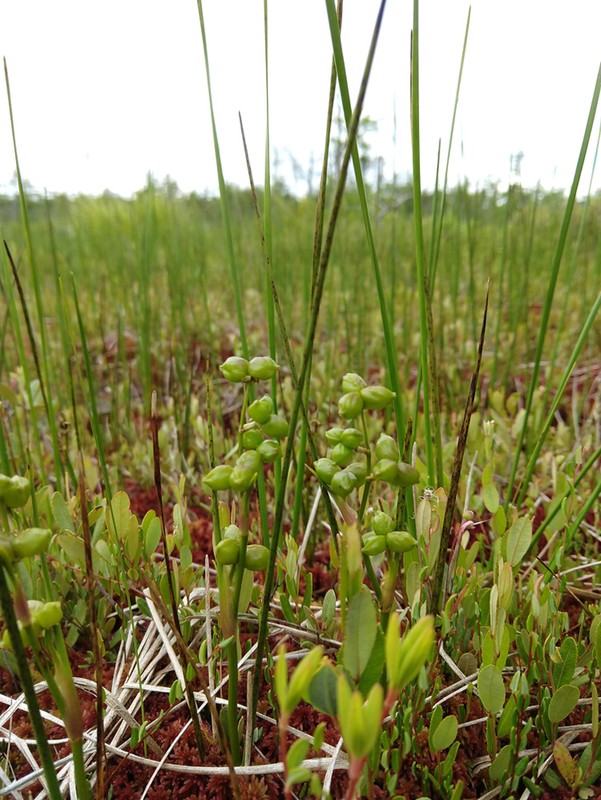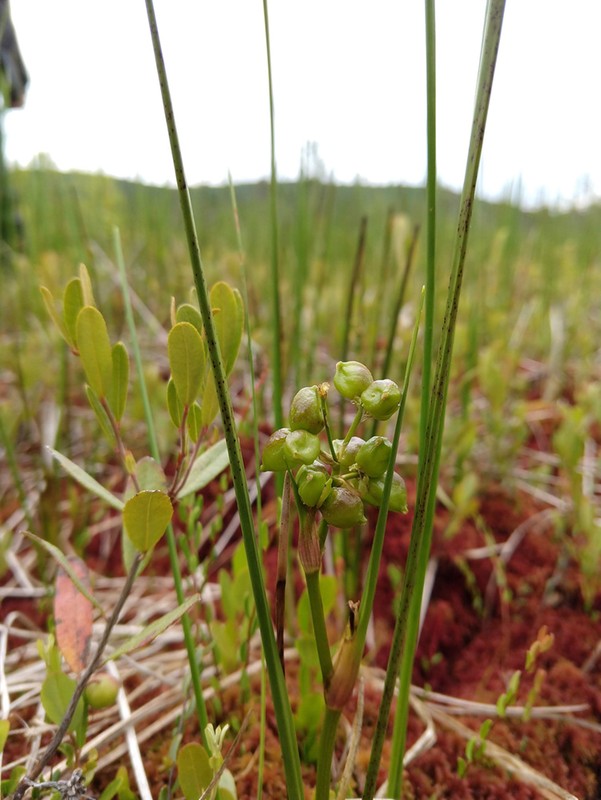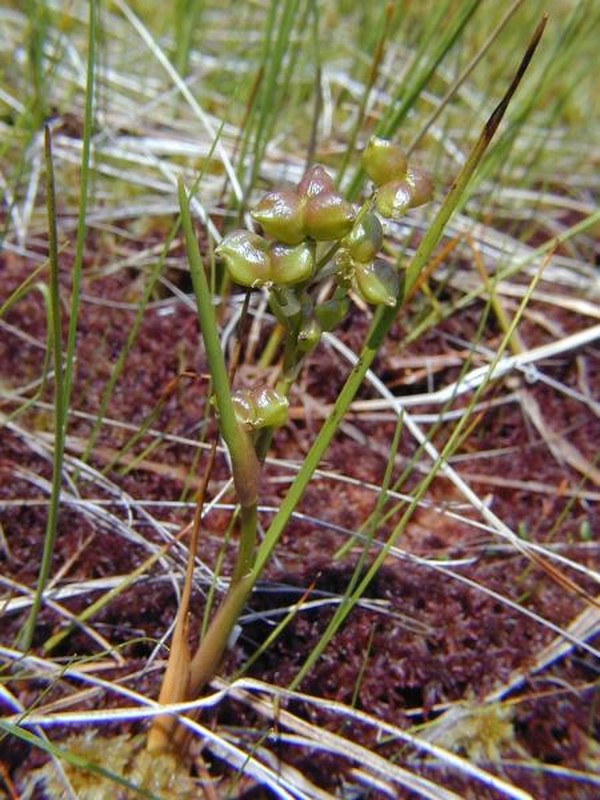Pod Grass
Scheuchzeria palustris L.
- Class
- Monocotyledoneae (Monocots)
- Family
- Scheuchzeriaceae (scheuchzeria family)
- State Protection
- Rare
A plant listed as Rare by New York State. Removal or damage without the consent of the landowner is prohibited.
- Federal Protection
- Not Listed
- State Conservation Status Rank
- S3
Vulnerable in New York - Vulnerable to disappearing from New York due to rarity or other factors (but not currently imperiled); typically 21 to 80 populations or locations in New York, few individuals, restricted range, few remaining acres (or miles of stream), and/or recent and widespread declines.
- Global Conservation Status Rank
- G5
Secure globally - Common in the world; widespread and abundant (but may be rare in some parts of its range).
Summary
Did you know?
For those who buy bags of peatmoss, you may occassionally find long rope-like strands mixed in with the peat. There is a good chance that these long-strands are rhizomes (i.e., underground stems) from pod grass (Scheuchzeria palustris). This plant is common in northern bogs where most of the peat is harvested. A detailed study of the peat allows you to identify other plant species from old stems or other parts located within the peat.
State Ranking Justification
There are 26 known populations of this peatland plant, with some populations containing hundreds of individuals. Possibly as many as a dozen more populations might be encounted through focused surveys in peatlands within the Adirondacks and Tug Hill.
Short-term Trends
Due to the specific habitat requirements, this plant has a limited range. However, due to various protection efforts, populations of this peatland plant have remained stable for the past 100 or so years.
Long-term Trends
In the distant past (i.e., prior to European colonization) this plant was likely more common. As peatlands were mined or otherwise altered, some popualtions were undoubtedly lost. Today peatlands are rarely altered, except for natural succession, and the forward-looking trend should see our current populations continuing long into the future.
Conservation and Management
Threats
As a peatland plant, this species is protected by various wetland regulations. The only possible threat is natural succession where shrubs may shade out this plant and alter the hydrological regime.
Conservation Strategies and Management Practices
As long as the peatlands where this plant is found are protected, there are no specific management requirements. If a peatland becomes too shrub dominated, specific measures to address this natural succession may be desired if the goal is to maintain an open peatland environment.
Research Needs
At this point, no research needs have been identified.
Habitat
Habitat
This plant is found in sphagnous bogs and nutrient poor to medium fens, mostly within the Adirondacks and Tug Hill regions. It often prefers the wet swales and depressions within these peatlands (New York Natural Heritage Program 2005) Sphagnum bogs, marshes, and lake margins (Flora of North America 2000). Sphagnum bogs (Rhoads and Block 2000). Cold sphagnum bogs (Gleason & Cronquist 1991). Almost entirely restricted to bogs, where it tends to thrive in wetter sphagnum areas (Voss 1972). Bogs, quagmires and peaty shores (Fernald 1970).
Associated Ecological Communities
- Black spruce-tamarack bog
(guide)
A conifer forest that occurs on acidic peatlands in cool, poorly drained depressions. The characteristic trees are black spruce and tamarack; in any one stand, either tree may be dominant, or they may be codominant. Canopy cover is quite variable, ranging from open canopy woodlands with as little as 20% cover of evenly spaced canopy trees to closed canopy forests with 80 to 90% cover.
- Inland poor fen
(guide)
A wetland fed by acidic water from springs and seeps. Plant remains in these fens do not decompose rapidly and thus the plants in these fens usually grow on older, undecomposed plant parts of mostly sphagnum mosses.
- Medium fen
(guide)
A wetland fed by water from springs and seeps. These waters are slightly acidic (pH values generally range from 4.5 to 6.5) and contain some dissolved minerals. Plant remains in these fens do not decompose rapidly and thus the plants in these fens usually grow on older, undecomposed plant parts of woody material, grasses, and mosses.
- Patterned peatland
(guide)
A large peatland whose surface forms a gentle slope with a mosaic of high and low areas (relative to water levels). These high and low areas occur as narrow or broad bands of vegetation and pools that extend perpendicular to the direction of water flow across the slope of the peatland. Peat moss (Sphagnum) is the most abundant plant.
Associated Species
- Andromeda glaucophylla
- Bartonia virginica (Virginia screwstem)
- Betula glandulosa (alpine birch, resin birch)
- Betula pumila (bog birch)
- Carex chordorrhiza (creeping sedge)
- Carex exilis (meager sedge)
- Carex lasiocarpa
- Carex limosa (mud sedge)
- Carex oligosperma (few-seeded sedge)
- Carex trisperma (three-fruited sedge)
- Chamaedaphne calyculata (leatherleaf)
- Cladium mariscoides (twig-rush)
- Drosera rotundifolia (round-leaved sundew)
- Eriophorum vaginatum (tussock cotton-grass)
- Iris versicolor (blue flag)
- Kalmia angustifolia
- Kalmia polifolia (bog laurel)
- Larix laricina (tamarack)
- Maianthemum trifolium (three-leaved Solomon's-seal)
- Myrica gale (sweet gale)
- Platanthera blephariglottis
- Pogonia ophioglossoides (rose pogonia)
- Rhododendron groenlandicum (Labrador-tea)
- Rhynchospora alba (white beak sedge)
- Sarracenia purpurea (purple pitcherplant)
- Sphagnum cuspidatum
- Sphagnum magellanicum
- Sphagnum majus
- Sphagnum rubellum
- Utricularia cornuta (horned bladderwort)
- Utricularia geminiscapa (hidden-fruited bladderwort)
- Vaccinium macrocarpon (cranberry)
- Vaccinium oxycoccos (small cranberry)
Range
New York State Distribution
Most popualtions of this plant are from peatlands within the Adirondacks, Tug Hill, and Oswego County. A few scattered populations range south to the Capital District and west along the Great Lakes Plain to Rochester.
Global Distribution
This is a circumboreal species that ranges from the south to northern New Jersey, northern Pennsylvania, Wisconsin, Minnesota, northern Idaho, and along the coast to northern California. There are disjunct populations in Virginia, West Virginia, Illinois, Iowa, and possibly New Mexico.
Identification Comments
General Description
Pod grass is a grass-like perennial herb with stems that are 2-4 dm high and arising singly from creeping rhizomes. Alternate, strap-like leaves that are 1-4 dm long, sheath the stem and become smaller upward. The lower stems are usually covered with old membranous sheathing bases. 3-12 stalked flowers are borne on the upper stem in the axils of reduced leaf sheaths. Each flower has 6 undifferentiated, greenish white, separate petals and sepals that are ca. 3 mm long, 6 stamens, and 3 ovaries that are united at the base. The (usually) 3 capsules are 5-8 mm long and have 2 seeds.
Identifying Characteristics
The zig-zagging stems range from 10-40 cm tall. The leaves are grass-like with conspicuously dilated sheaths where the basal leaves are clustered with overlapping sheaths. There are 1-3 stem leaves that are well separated. The leaf- blades are erect, 5-30 cm long, 1-3 mm wide, and have a distintive pore at the apex. The few-flowered (2-14) racemes are 3-10 cm long. The lowest bract is foliaceous and has a well developed blade. The second bract only has a small blade (or none at all), and the others are reduced to small, bladeless sheaths. The fruits form 3 diverging and inflated 1-2 seeded follicles that are 6-7(10) mm long, brown or straw color, and with a curving beak 0.5-1 mm long.
Best Life Stage for Proper Identification
In order to help locate the plant and develop a better visual search image, this plant is easiest to locate when in fruit. It may be identified at any life stage, including dead rhizomes. It is probably best to collect an entire stalk, including stem, leaves, and mature fruit, if you need someone to verify the identification. Photos may also be used for verification.
Similar Species
This plant is very unique when in fruit or flower. It may be overlooked when found with various rushes and grasses, but it is easy to identify once noticed.
Best Time to See
This plant flowers in early spring and fruits are produced shortly thereafter. Surveys may be conducted at any point during the growing season, but they may be most effective when this plant is fruting. Sometimes this plant can be overlooked, especially when various rushes are present.
- Vegetative
- Flowering
- Fruiting
The time of year you would expect to find Pod Grass vegetative, flowering, and fruiting in New York.
Pod Grass Images
Taxonomy
Pod Grass
Scheuchzeria palustris L.
- Kingdom Plantae
- Phylum Anthophyta
- Class Monocotyledoneae
(Monocots)
- Order Najadales
- Family Scheuchzeriaceae (scheuchzeria family)
- Order Najadales
- Class Monocotyledoneae
(Monocots)
- Phylum Anthophyta
Additional Common Names
- Rannoch-rush
- Scheuchzeria
Synonyms
- Scheuchzeria americana (Fern.) G.N. Jones
- Scheuchzeria palustris ssp. americana (Fern.) Hulten [If subspecies are recognized, ours would all be this subspecies.]
- Scheuchzeria palustris var. americana Fern. [If varieties are recognized, ours would all be this variety.]
Comments on the Classification
Some manuals treat the North American plants as a separate subspecies or variety. Flora of North America reports "variability in [follicle and stigma characters], in specimens from both hemispheres, vitiates their worth for varietal distinction" (FNA 2000).
Additional Resources
Best Identification Reference
Flora of North America Editorial Committee. 2000. Flora of North America north of Mexico. Vol. 22. Magnoliophyta: Alismatidae, Arecidae, Commelinidae (in part), and Zingiberidae. Oxford Univ. Press, New York. xxiii + 352 pp.
Other References
Fernald, M.L. 1950. Gray's manual of botany. 8th edition. D. Van Nostrand, New York. 1632 pp.
Gleason, Henry A. and A. Cronquist. 1991. Manual of Vascular Plants of Northeastern United States and Adjacent Canada. The New York Botanical Garden, Bronx, New York. 910 pp.
New York Natural Heritage Program. 2005. Biotics Database. Albany, NY.
New York Natural Heritage Program. 2024. New York Natural Heritage Program Databases. Albany, NY.
Reschke, Carol. 1990. Ecological communities of New York State. New York Natural Heritage Program, New York State Department of Environmental Conservation. Latham, NY. 96 pp. plus xi.
Voss, E.G. 1972. Michigan Flora, Part I. Gymnosperms and Monocots. Cranbrook Institute of Science Bulletin 55 and the University of Michigan Herbarium. Ann Arbor. 488 pp.
Links
About This Guide
Information for this guide was last updated on: February 1, 2023
Please cite this page as:
New York Natural Heritage Program. 2024.
Online Conservation Guide for
Scheuchzeria palustris.
Available from: https://guides.nynhp.org/pod-grass/.
Accessed July 27, 2024.



